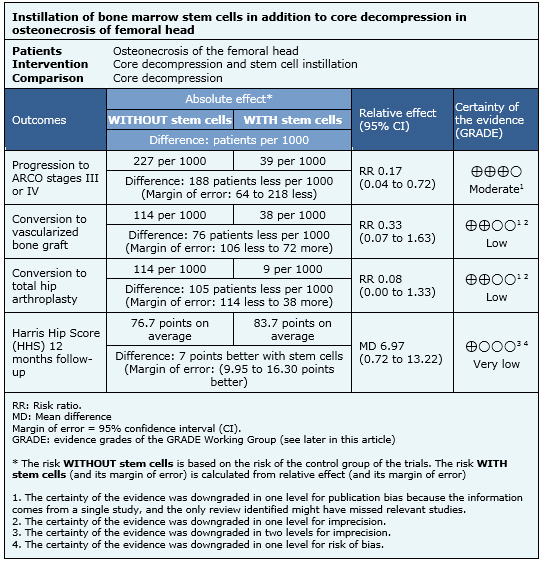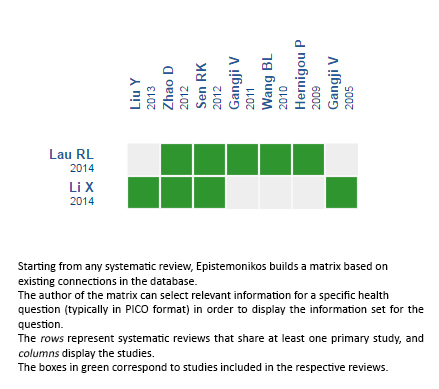Resúmenes Epistemonikos
← vista completaPublicado el 25 de marzo de 2016 | http://doi.org/10.5867/medwave.2016.6406
¿Es útil la instilación de células madre de médula ósea al momento de la descompresión ósea en la osteonecrosis de cabeza femoral?
Is instillation of bone marrow stem cells at the time of core decompression useful for osteonecrosis of the femoral head?
Abstract
Osteonecrosis of the femoral head leads to degeneration of the head and finally to osteoarthritis of the hip. Decompression is the most widely used treatment, but its effectiveness is limited. It has been proposed instillation of stem cells in addition to decompression, would lead to better results. Searching in Epistemonikos database, which is maintained by screening 30 databases, we identified two systematic reviews including two randomized trials. We combined the evidence using meta-analysis and generated a summary of findings table following the GRADE approach. We concluded instillation of bone marrow stem cells at the time of core decompression probably slows progression to osteoarthritis of the hip in patients with osteonecrosis of the femoral head and might reduce the need of subsequent surgeries. It is unclear whether it has any effect on the functionality because the certainty of the evidence is very low.
Problem
Osteonecrosis of the femoral head mainly affects adults between the third and sixth decade of life. It has multiple causes, but it is generally produced by a severe deficiency of blood flow leading to bone necrosis and subsequent collapse of the femoral head. In the absence of early intervention with intention to preserve the native joint, there is a high risk of developing osteoarthritis of the hip.
Decompression is the most widely used treatment for avascular necrosis of the femoral head, but its effectiveness is limited.
Use of mesenchymal stem cells from adult bone marrow, in addition to decompression, would promote bone formation and neovascularization, which could improve prognosis in early stages of osteonecrosis. However, there is controversy about whether its ability to improve joint function or to increase the time until requirement of total hip arthroplasty.
Methods
We used Epistemonikos database, which is maintained by screening more than 30 databases, to identify systematic reviews and their included primary studies. With this information, we generated a structured summary using a pre-established format, which includes key messages, a summary of the body of evidence (presented as an evidence matrix in Epistemonikos), meta-analysis of the total of studies, a summary of findings table following the GRADE approach and a table of other considerations for decision-making.
|
Key messages
|
About the body of evidence for this question
|
What is the evidence. |
We found two systematic reviews [1],[2] which included seven primary studies [3],[4],[5],[6],[7],[8],[9], two of them [3],[4], corresponded to randomized controlled trials. This table and the summary in general are based on the latter. |
|
What types of patients were included |
One study [4] included patients between 18 and 55 years of age with osteonecrosis of one or both hips stages IC to IIC according to the ARCO ( Association Research Circulation Osseous) classification with risk factors such as trauma, steroid use, alcohol abuse, Caisson disease or idiopathic aetiology (some patients had more than one cause). The other randomized study [3] included patients without specifying age with osteonecrosis of one or both femoral heads ARCO stage I or II (without subtype specification), of varied aetiologies including traumatic, steroid use, alcohol abuse, Cushing's disease, pregnancy induced and idiopathic. |
|
What types of interventions were included |
Both studies included as intervention stem cells derived from bone marrow injected into the necrotic area through a tunnel of decompression. One study [3] used a concentrate of mononuclear cells derived from bone marrow obtained from iliac crest, in doses of 5x108 cells (total mononuclear cell count). The second study [4] used mesenchymal stem cells obtained after two weeks of culture of concentrate mononuclear cells derived from bone marrow obtained from the sub trochanteric region of the affected femur at doses of 2x106 cells (total mesenchymal stem cell count). Both studies compared against core decompression alone |
|
What types of outcomes |
Harris Hip Score, progression to a more advanced stage according to ARCO classification, volume of necrotic area assessed by magnetic resonance, progression and need of vascularized bone graft or conversion to total hip arthroplasty. |
|
We found three systematic reviews [5], [6], [7], including 14 studies reported in 21 references [8], [9], [10], [11], [12], [13], [14], [15], [16], [17], [18], [19], [20], [21], [22], [23], [24], [25], [26], [27], [28]. Eight studies correspond to randomized controlled trials (15 references [9], [10], [11], [12], [13], [14], [16], [17], [19], [21], [22], [23], [24], [26], [27]). This table and the summary in general are based on the latter. One study [15] did not contribute data to any of the outcomes of interest. |
Summary of findings
Information on the effects of instillation of stem cells at the time of core decompression in osteonecrosis of the femoral head is based on two randomized controlled trials [3],[4] including 148 cases in 133 patients. Information about progression, conversion to bone graft and conversion to total hip arthroplasty are based on one study [4]. The functionality is based on a second study [3].
- Instillation of bone marrow stem cells at the time of core decompression probably slows progression in early-stage osteonecrosis of the femoral head. The certainty of the evidence is moderate.
- Instillation of bone marrow stem cells at the time of core decompression in osteonecrosis of the femoral head might decrease conversion to vascularized bone graft. The certainty of the evidence is low.
- Instillation of bone marrow stem cells at the time of core decompression in osteonecrosis of the femoral head might decrease the conversion to total hip arthroplasty. The certainty of the evidence is low.
- It is unclear whether bone marrow stem cells instillation upon core decompression in osteonecrosis of femoral head improves functionality because the certainty of the evidence is very low.


Other considerations for decision-making
|
To whom this evidence does and does not apply |
|
| About the outcomes included in this summary |
|
| Balance between benefits and risks, and certainty of the evidence |
|
| Resource considerations |
|
|
Differences between this summary and other sources |
|
| Could this evidence change in the future? |
|
How we conducted this summary
Using automated and collaborative means, we compiled all the relevant evidence for the question of interest and we present it as a matrix of evidence.

Follow the link to access the interactive version: Core decompression and stem cell instillation versus core decompression alone for early stage osteonecrosis of the femoral head
Notes
The upper portion of the matrix of evidence will display a warning of “new evidence” if new systematic reviews are published after the publication of this summary. Even though the project considers the periodical update of these summaries, users are invited to comment in Medwave or to contact the authors through email if they find new evidence and the summary should be updated earlier. After creating an account in Epistemonikos, users will be able to save the matrixes and to receive automated notifications any time new evidence potentially relevant for the question appears.
The details about the methods used to produce these summaries are described here http://dx.doi.org/10.5867/medwave.2014.06.5997.
Epistemonikos foundation is a non-for-profit organization aiming to bring information closer to health decision-makers with technology. Its main development is Epistemonikos database (www.epistemonikos.org).
These summaries follow a rigorous process of internal peer review.
Conflicts of interest
The authors do not have relevant interests to declare.

